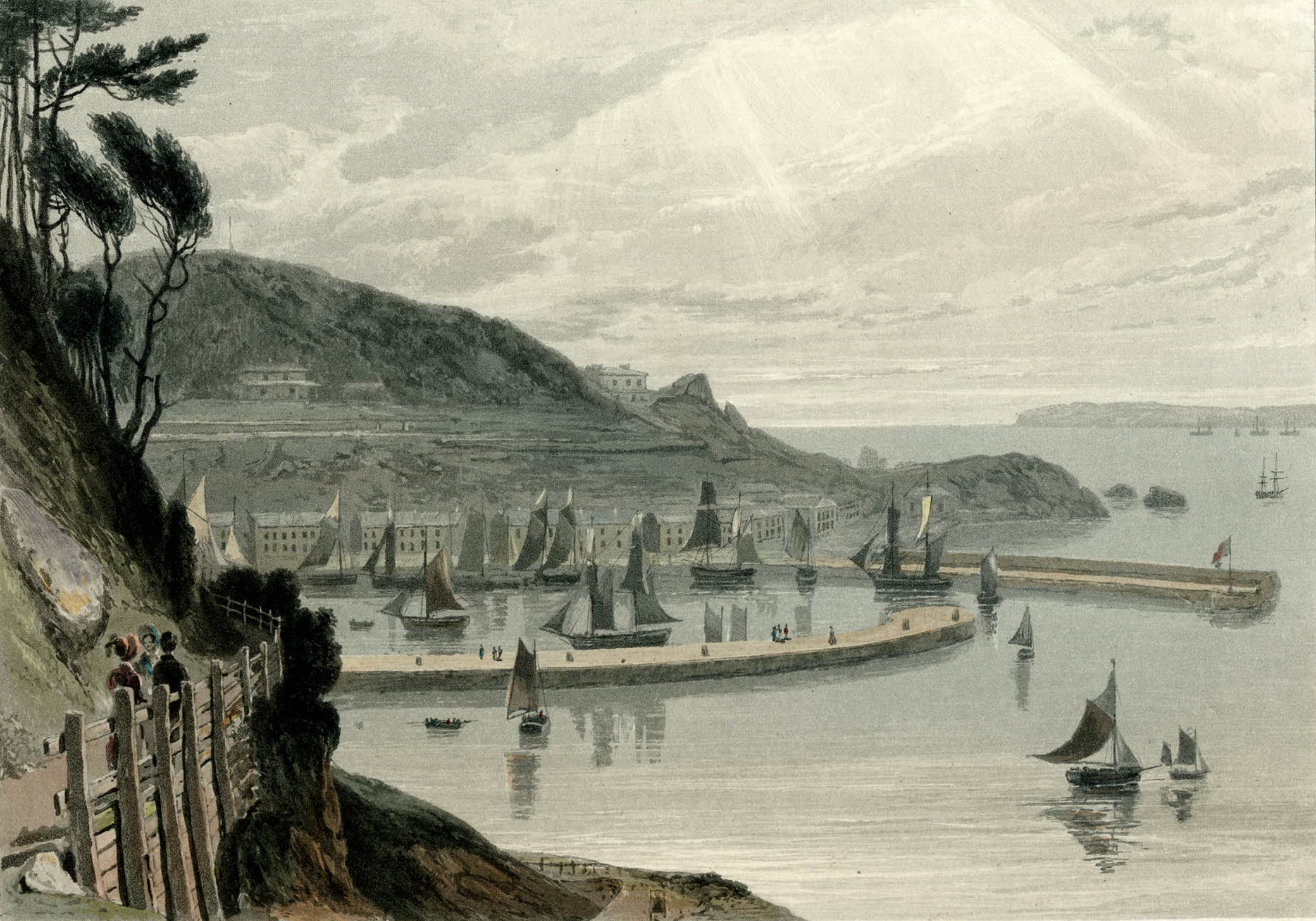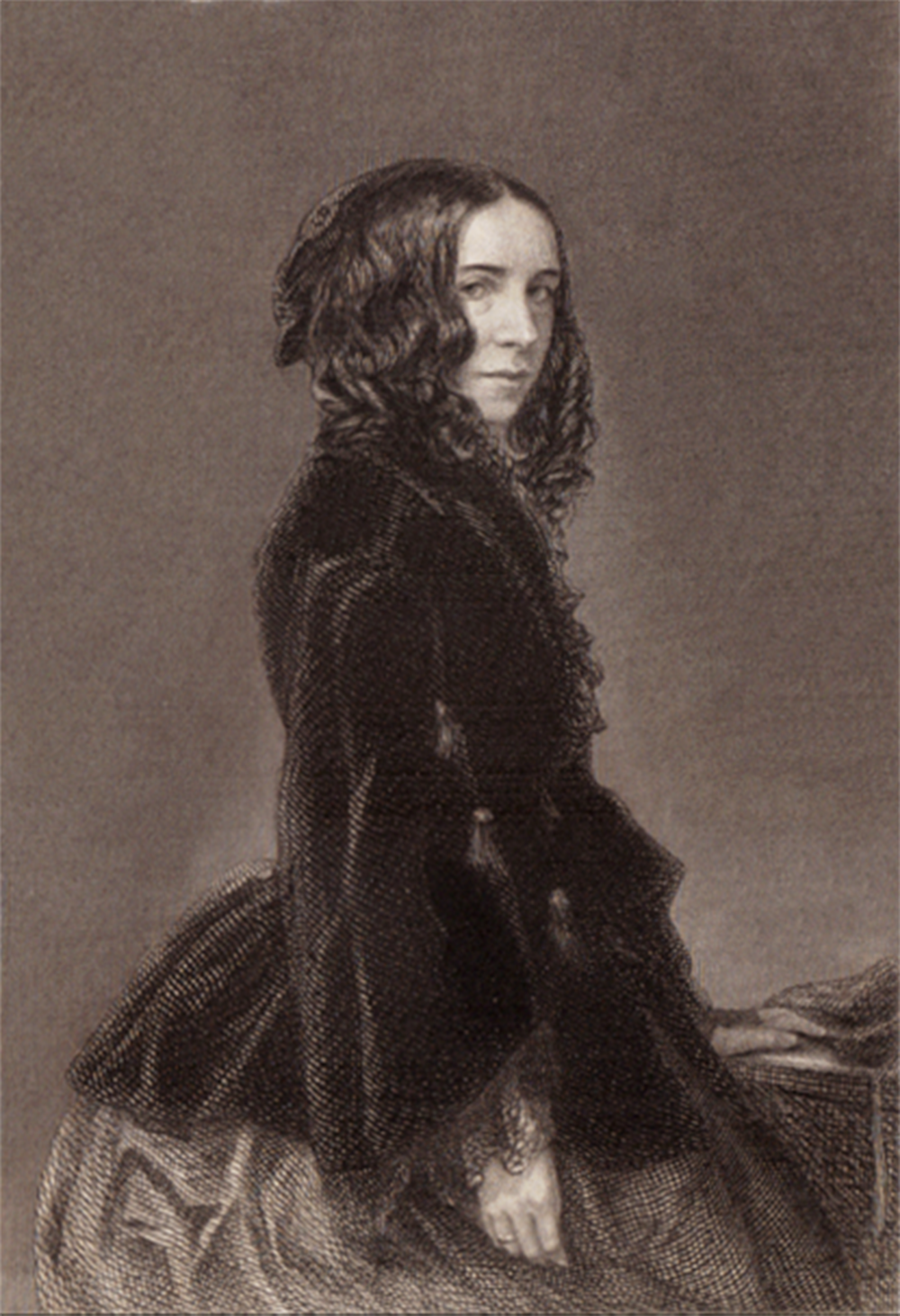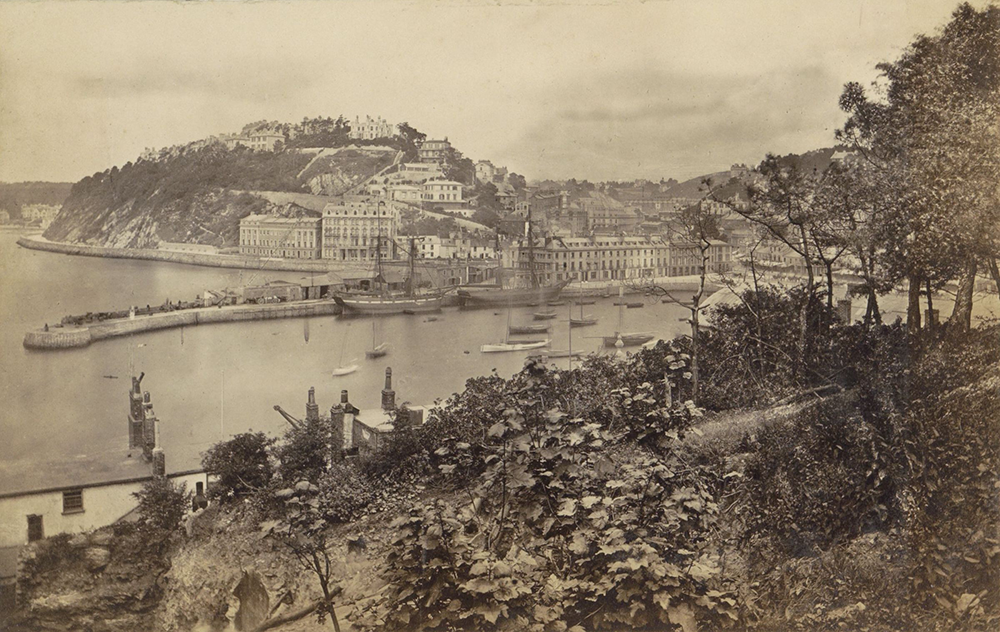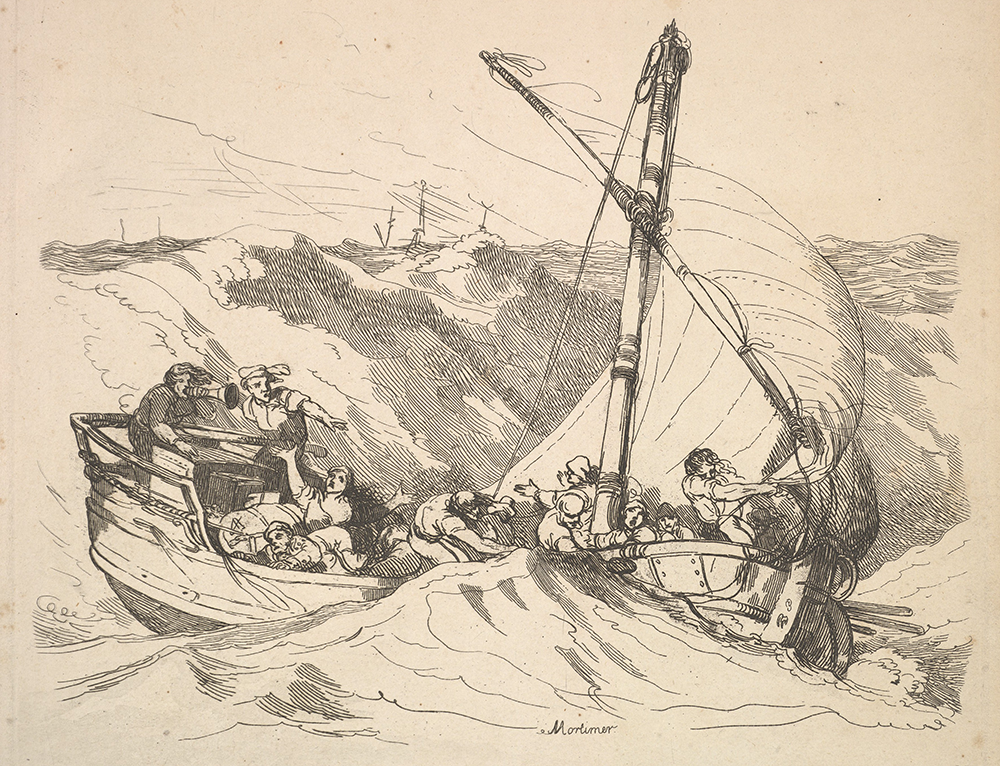
Torquay, Devon, by William Daniell, 1825. The British Museum.
In the summer of 1838 a young woman arrived in Torquay on the southwest coast of England, sent there by her father to alleviate an illness no one could name, but that had rendered her an invalid since she was a teenager. For her this seaside resort was just that: a resort, perhaps her last.
Elizabeth’s family, the Barrett-Moultons, owned slave-run plantations in Jamaica. Sugar had paid for the house in which she grew up, an ornate, oriental-styled mansion in Herefordshire resembling the Brighton Pavilion, the Prince of Wales’ marine folly, complete with concrete minarets, doors inlaid with mother-of-pearl, and a tunnel that led from the house to the gardens and their grottoes. Ominously named Hope End, its fantasy was bought by the toil of stolen people; it might have been built out of sugar. Set against its refined whiteness, Elizabeth believed herself to possess black blood, a result of her ancestors’ illicit liaisons.
At fifteen, Elizabeth begun to suffer chronic ill health. She took opium to relieve her symptoms, and would do so for the rest of her life. But her true solace was poetry. She was already writing and publishing her work while Keats, Shelley, and Byron were still alive, and she fell under their influence; the onset of her illness coincided with the appearance of Shelley’s Adonaïs. She was, in her mind, heir to Shelley, fated with his spirit, as if with his watery death his power were to pass on to her. In her fragile state she held fast to his “perfect exquisition.” It was her article of faith, her destiny. “I always imagine,” she wrote, “I was sent on the earth for some purpose.”
And as with the contrast between Shelley’s physical body and his ferocious spirit, so it is difficult to reconcile Elizabeth’s fierce ambition with the shy face that peers out from her dark curls, their weight making up for the weakness of her bird-like body. No one was ever sure of the nature of her suffering, not even Elizabeth herself. She was subject to that uncertainty. She spent months suspended in a “spine crib,” a hammock hanging four feet off the floor as though she were on a hospital ship. Heated glass cups were used to bring her blood to the surface, leeches applied to suck it out, and, perhaps most extraordinary of all, setons were employed—silk sutures or strips of canvas threaded on needles through pinched folds of her skin, as if she were being sewn up. Cupped, bled, pierced, and suspended, her treatments amounted to an exorcism, drawing out bad spirits or ectoplasm. It was as though the century itself, all its appropriations and abuses, was impacting physically on her body, her frail flesh martyred to the Industrial Revolution.

In 1832 a black rebellion in Jamaica and the impending abolition of slavery forced the Barretts to abandon Hope End and its domes. Their fortunes reduced, they moved to Sidmouth on the Devon coast, partly for Elizabeth’s health. She was entranced. She declared the sea to be visible poetry, “the sublimest object in nature,” where “the grandeur is concentrated upon the ocean without deigning to have anything to do with the earth.” She loved the moonlight on the water by night, and her sister Arabella swam in it every day, even in December.
The sea was an opening more effective than any suture. And Elizabeth’s happiness was complete when her beloved younger brother Edward came back from the family’s estate in Jamaica, his return made more dramatic when he’d “nearly died a glorious death” on the way home across the Atlantic, supposedly poisoned by “a dolphin which had hung in the moonshine!” It was a voodoo-like notion, evoking the watery spirits of the Caribbean, where I once saw a boat rowed out with a Haitian mambo priestess sitting in it, her head wound with a white turban, casting offerings of cigarettes and rum to the lwa, the spirits of the deep who were thought to drag the unwitting down into their domain. “The moonshine poisoned the dolphin, and the dolphin poisoned Bro,” Elizabeth reported, unaware that in the Caribbean, the dolphin was also a fish, “and poor Brozie grew quite black and swollen in the face. Would it not have been a glorious death—to die of a dolphin and moonshine?”
After three years in Sidmouth the Barretts resettled in Marylebone, London, in whose airless streets Elizabeth’s health relapsed. Suffering from affected lungs, it was decided that she must return to the sea, and so she was sent to Torquay, where her aunt and uncle lived. Unable to bear the motion of a carriage—one modern diagnosis of her condition suggests that she suffered from spinal tuberculosis, causing extreme sensitivity and twisting to her vertebrae—Elizabeth sailed from London to Plymouth, along with Edward and two of her sisters. She feared the journey more than going to the North Pole, but she was the only woman on board not to suffer seasickness, and boasted of her “oceanic reputation.” After staying with their relatives, Elizabeth and her siblings moved to a tall townhouse on Beacon Hill, overlooking a signaling point on the harbor at one end of the great curving bay. At the other, in the distance, was Berry Head, in whose deep waters dolphins swam and gannets dived and where, in 1815, sightseers had flocked to catch a glimpse, not of a whale, but of the Emperor Napoleon on HMS Bellerophon, on his way to exile on St. Helena.
Torquay was newly fashionable; Tennyson, who visited in the same year that Elizabeth arrived, called it “the loveliest sea village in England.” Backed by the wildness of Dartmoor, set between the Dart and the Teign, its climate was dry, and its hills strewn with white villas and terraces. It was as close as England could get to the Mediterranean. The blue sea clashed with the red cliffs, scorched when prehistoric Devon had lain under equatorial sun. At last, Elizabeth was back by the sea. “Here, we are immediately upon the lovely bay,” she wrote in a letter, “a few paces dividing our door from its waves.” Their windows looked onto the water, “and our ears are as familiar as its rocks are, with the sound.” Like her hero Shelley at the Casa Magni on the bay of Spezia in Italy, she was in direct communion with her muse.

“Our house here is in the sea,” she told another friend. “At least to my imagination it is—which is the same you know as its being so actually.” Whenever the steam packet entered or left the harbor her bed shook; the building at the end of their terrace was actually flooded by the sea, by invitation. The Bath House, established in 1817 during the Regency craze for sea bathing, allowed the tide to flow “through the wall of the pier into a spacious reservoir,” where it was filtered to remove weed and other organisms. In this therapeutic machine, a human aquarium, Elizabeth could take the saltwater cure without having to brave the open sea. Yet she was determined to experience the water, and despite her frailty she often went sailing, accompanied by her maid Crow, perhaps on loan from Thomas Love Peacock’s Nightmare Abbey.
Suspended from the land without medical aids, Elizabeth discovered a new vision of delight. “My love of water concentrates itself in the boat,” she said. But there were plans to upset her idyll. When her aunt and uncle moved to Merry Oak, on the outskirts of Southampton—half a mile from where I am writing this—it was proposed that Elizabeth should go with them. She was horrified. It may have been a fashionable spa, but Elizabeth had “taken a great dislike for Southampton…on account of the dampness of the place, occasioned by all the wet mud of the river,” even though she had yet to visit the town. Her physician, Dr. Barry, supported her prejudice, and expressly advised against the move as potentially injurious to her health. Just as Sylvia Plath was never sent to Provincetown, Elizabeth did not go to Southampton; she was allowed to remain in Torquay—despite the fact that, “as to its human aspect, it is much more like a hospital than anything else.”
The sea’s promise of life was undermined by the presence of death, here at the termination of the land. And although the water was always in view, Elizabeth was confined, like those sea baths; sometimes she would not leave her room for weeks on end. Her days were only relieved by the presence of Bro, who would bring her presents such as a “very beautiful silver remember medal” of Byron, and who lay talking on her bed for hours. She may have disapproved of him attending parties at which laughing gas was inhaled—worried that, at the age of thirty-one, his talents were being dissipated in a seaside place, where life seemed so much looser—but Bro was more like a lover to her, filling the space a suitor might have occupied.
Despite Bro’s attentions, Elizabeth became bored and depressed. The household moved to 1 Beacon Terrace, a cheaper lease. She had lost faith in the sea, relying on a different drug. “Opium—opium—night after night!” she wrote, “and some nights even opium won’t do.” Her lungs began to hemorrhage; her skin was constantly blistered by her doctor. After two years in Torquay her health did not seem to be improving at all. Rather, the reverse: she was convinced that death was near.
As it was: but not hers. In February 1840, Elizabeth received news that her younger brother Sam had died of a fever in Jamaica. She was still recovering from the shock when five months later, on July 11, Bro, along with his twenty-one-year-old friend the Honourable Charles Vanneck, went sailing on La Belle Sauvage. Also on board was the thirty-five-year-old Captain Carlyle Clarke of the Indian Army, and an experienced young sailor named White. None of them returned alive.

The yacht was last seen that Saturday afternoon, two or three miles off Teignmouth. It was a summer sea with only a brief squall. The witness, the aptly named Richard Wake of Heavitree, observed that the boat was “sailing under a heavy press of canvas at the time she went down.” She seemed to sink in seconds, as if a hand had reached up from below. One of Wake’s sailors saw the mast sticking out of the water—all but with a cormorant perched on its top—“and that disappeared.” When Wake arrived on the scene there was no trace of the boat or its crew; “not a hat, oar, or any other vestige remained.” Boats sent to drag the bottom with grapnels found nothing either.
As Mary Shelley had awaited news of her husband, so this lack of evidence created a terrible absence. It was as if Bro had been taken by the spirits of the sea. The cruelness lay in the water which Elizabeth could see from her window: “he had left me! gone! For three days we waited—and I hoped while I could—oh—that awful agony of three days! And the sun shone as it shines to-day, and there was no more wind than now; and the sea under the windows was like this paper for smoothness—and my sisters drew the curtains back that I might see for myself how smooth the sea was, and how it could hurt nobody—and other boats came back one by one.”
All in the party could swim, save the sailor. Perhaps Bro had made it ashore? Their father, arriving to deal with the disaster, indulged in the hope—“billow upon billow pass over me”—that his son might be found alive. But the local paper was hardly encouraging—“Fatal Catastrophe Off our Coast! Four Lives Lost!”—quoting, with further melodrama, from William Falconer’s “The Shipwreck,” “The hostile waters closed around their head | They sank, for ever numbered with the dead,” and publicizing rewards for anyone who found linen cast ashore “marked with the initials of the beloved dead.”
Six days later, Captain Clarke’s corpse was pulled from the water by a Brixham trawler crewed by the two sons of the fishing port’s vicar, Francis Lyte, the composer of the hymn “Abide with Me.” Clarke’s body was unblemished, his buttonhole still in his lapel. It took three more weeks before Bro’s body was seen, floating a mile and a half out in the bay. “On being examined it was found a little mutilated in the face and hands.” His gold watch, a purse containing sixteen shillings in silver, a pencil case, cigar box, gold ring, and pocket handkerchief marked E.M.B. were still about his person: all the accoutrements of a carefree young man about town.
Elizabeth was racked with guilt, because her father had disapproved of Edward going to Torquay. She was being punished. The sea which had summoned her in hope had taken her hope, the one person for whom her life was worth living. Now she could not wait to get away from “this dreadful dreadful place…These walls—& the sound of what is very fearful a few yards from them—that perpetual dashing sound, have preyed on me. I have been crushed, trodden down. God’s will is terrible!”
Later, after she had become the most famous female poet of her age, legend would create an impossible scene of Elizabeth on a balcony, looking out to the bay as Bro perished in the waves, as if she had watched him being dragged down below. “The associations of this place, lie upon me, struggle as I may, like the oppression of a perpetual night-mare. It is an instinct of self-preservation which impels me to escape—or to try to escape.” The sea evoked weird, woozy images that seemed to be products of her addiction. In an essay on the Greek poets published soon after Bro had drowned she discussed a dead language, “pang by pang, each with a dolphin color—yielding reluctantly to that doom of death and silence which must come at last to the speaker and the speech. Wonderful it is to look back fathoms down the great past, thousands of years away.” Transported in time and space, she associated her loved one with a cetacean, a transmutative shapeshifter who might not have drowned at all, but become something rich and strange instead, like the hero he had always been to her: “Faint and dim | His spirits seemed to sink in him— | Then, like a dolphin, change and swim.”
Adapted with permission from RISINGTIDEFALLINGSTAR: In Search of the Soul of the Sea by Philip Hoare, published by the University of Chicago Press. Copyright © 2018 by Philip Hoare. All rights reserved.